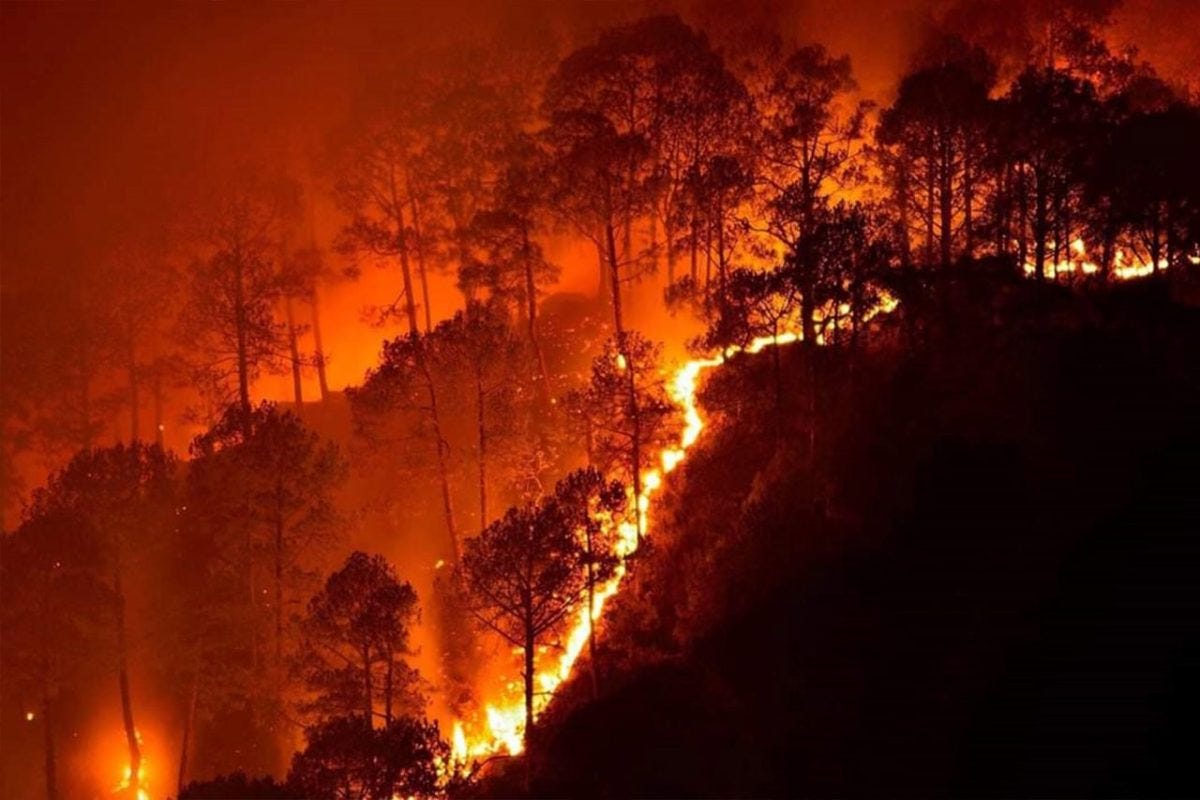Learning This Week: Forest Fires
Every week I learn something interesting about a topic.
If you have not signed up for the free newsletter yet, consider doing so now at https://intelsense.substack.com
A forest fire, also known as a wildfire, is an uncontrolled and unpredictable fire in areas with dense vegetation, such as forests, grasslands, or brushlands. It is fueled by dry vegetation, oxygen, and a heat source. Natural causes like lightning or volcanic activity or human activities such as discarded cigarettes, unattended campfires, or arson often ignite it.
Forest fires can spread rapidly due to wind and topography, causing extensive damage to ecosystems, wildlife, and human settlements. While they can have devastating effects, including air pollution and economic losses, some ecosystems rely on periodic fires to regenerate and maintain ecological balance. Climate change and deforestation have exacerbated the frequency and intensity of these fires globally.
Forest Fires in India
Forest fires are a recurring issue in India, particularly during the dry season from November to June, with peak incidents in March, April, and May. Nearly 36% of India's forests are prone to fires, with 10% classified as highly vulnerable. Regions like Uttarakhand, Odisha, Chhattisgarh, Maharashtra, and the Northeast are hotspots due to their dry deciduous forests and human activities like shifting cultivation and land clearing. For example:
Uttarakhand: The state has faced widespread fires, such as the 2016 disaster that burned 4,538 hectares and caused significant ecological and economic damage. In 2023-24 alone, it reported over 11,000 fire incidents affecting nearly 1,100 hectares.
Odisha: Known for frequent large-scale fires, the state recorded over 20,000 fire points in the 2023-24 season, with damage spanning 2,463 sq km.
Maharashtra: In districts like Gadchiroli, over 7,000 fire incidents were reported in 2023-24. The state saw a burnt area of 4,095 sq km.
Bandipur (Karnataka): In 2019, a massive fire destroyed over 60 sq km of forest.
The economic impact is severe; forest fires in India result in annual losses estimated at ₹440 crore (US$100 million), including timber loss and ecosystem damage. Beyond property damage, they disrupt livelihoods dependent on forests and exacerbate climate change through carbon emissions.
Preventing Forest Fires
Preventing forest fires requires a combination of individual responsibility, community efforts, and sustainable forest management practices. Key measures include:
Safe Fire Practices: Always extinguish campfires, bonfires, and outdoor fires completely with water and dirt. Avoid starting fires on windy days and ensure fire pits are cleared of vegetation and surrounded by stones.
Proper Disposal: Dispose of smoking materials like cigarette butts and matches in closed containers or water to prevent accidental ignition.
Controlled Burns: Use prescribed or controlled burning to clear dry vegetation safely under supervision, reducing potential fuel for wildfires.
Firebreaks and Tree Spacing: Create firebreaks—strips of land cleared of vegetation—and maintain proper spacing between trees to prevent the spread of fire.
Defensible Space Around Homes: Remove flammable vegetation near homes, prune trees, and use fire-resistant landscaping to reduce risks in wildfire-prone areas.
Equipment Maintenance: Ensure vehicles, machinery, and tools have spark arrestors and avoid parking on dry grass to prevent accidental sparks.
Community Involvement: Participate in local forest fire prevention programs, such as Joint Forest Management Committees (JFMCs), and follow local regulations on open burning.
Summary
Forest fires can be very dangerous. Climate change is exacerbating the challenges every passing year. By combining prevention strategies with modern technologies like satellite monitoring for early detection, communities can significantly reduce the risk of devastating forest fires.
Note:
For equity advisory services visit intelsense.in
To know more about our PMS, email us at equity@shreerama.co.in
DISCLAIMER:
Investments in the securities market are subject to market risks. Read all the related documents carefully before investing.
SEBI Registered Research Analyst - Cupressus Enterprises Pvt Ltd - INH000013828.
Registration granted by SEBI and certification from NISM in no way guarantee the performance of the intermediary or provide any assurance of returns to investors.




